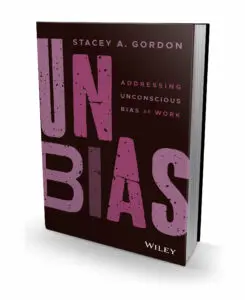When companies say they would like to take action to deal with unconscious bias at work, they’re usually referring to their recruiting and hiring process. Recruiters and talent acquisition professionals bear the brunt of the scrutiny when it comes to increasing diversity in the workplace. I’ve spoken with CEOs, directors of talent acquisition, human resource professionals, as well as individual recruiters and hiring managers, and what I have found is a disconnect between the goal of achieving diversity and the plan for getting there. There is a misconception that if a company does not have a diverse employee population, it is because recruiters have been unable to identify diverse talent. Company leaders are quick to lay the blame at the feet of recruiters or on the diverse individuals themselves, by saying they aren’t sufficiently qualified to apply.
The most qualified candidate may not be the right candidate
It is common to hear hiring managers state they simply want to hire the most qualified person for the job. That statement, on its face, sounds so innocent and factual. Who doesn’t want to hire the most qualified person for the job? However, that statement presupposes a number of things.

First, saying you want to hire the most qualified person for the job, but you systematically hire a white male every single time. This implies you really believe that every time, in every instance, for every job opening, a white male has been the best and most qualified candidate. Take a pause and reread that last sentence. Reflect on it for a moment and then tell me if you still believe there is no bias in your recruiting and hiring process.
Second, there is never usually only one most qualified person for the job. There are usually several individuals who are highly qualified and could do the job extremely well. How you decide between those highly qualified candidates is yet another place that unconscious bias is evident. In my course on unconscious bias, I discuss some of the more prevalent and pervasive forms of bias, such as affinity bias, groupthink, perception bias, the halo effect, confirmation bias, and gender bias.
Third, simply working hard and following the rules will ensure you get ahead. This meritocracy argument has to be dismantled. There is a bias toward hiring graduates from Ivy League schools, and in the legal field this practice is especially prominent. To get the top job at the highest-paying law firm, you have to graduate in the top 10% of your class and attend one of the best schools. In a meritocracy, everyone is evaluated on merit. However, this is flawed because for a meritocracy to work, everyone has to be objective and without bias of any kind.
A professor at MIT’s Sloan School of Management explored how meritocracy and HR practices actually work in the workplace. In a study of 9,000 employees, it was revealed that despite stating that “performance is the primary basis for all salary increases,” in actuality, women and underrepresented minorities had to work harder and achieve higher performance scores in order to receive the same salary increases as white men.
Setting goals equals accountability
The plan for achieving diversity has to include goals. Most company leaders do not want to set targets for goals or be specific at all about how they are going to increase diversity because being specific creates accountability.
Accountability requires action and action requires leadership.
The need for being specific
When was the last time you accomplished something but were not specific about how you were going to get it done? The answer to that question is never. Never in the history of “doing” have you just thought about a task and it magically got accomplished by itself.
The main excuse leaders use for not being specific is that specificity equates to quotas. However, contrary to popular belief, people of color want to be recognized and hired for their skills and ability, just like everyone else. Quotas are disliked by people of color because nobody wants to work for a company that is being forced to hire them.
The plan for achieving diversity has to be specific because diversity counts the people. Numbers are always specific, and you have to know the demographics of your company in order to design a plan for how you are going to shift. That does not mean that you are going to make an edict that you must hire 20 women over the next two months. However, you can put a process in place for increasing the number of women in your pipeline by analyzing the effectiveness of the sources you use to recruit women from, improving the brand marketing that you use to attract women to your company, and understanding the demographic makeup of the surrounding community where these women will ultimately work.
Watch for a lack of buy-in
Unconscious bias in the recruiting process is apparent in the lack of buy-in from leaders. There is no alignment to the creation of a process for increasing diversity because many leaders are unsure they can be successful due to their bias and their belief in the narrative that there are no highly qualified diverse individuals.
This is compounded by their belief that diversity recruiting is unnecessary because if you simply hire the best person, qualified diverse candidates will just rise to the top automatically if they are the most qualified.
Finally, many leaders don’t actually want to take any action. They just want to talk about the issue and appear as though they plan to do something about it but continue along with business as usual because they enjoy the status quo, and it is working for them.
In 2017, when Google announced they were launching Google for Jobs, their reasoning was because the problem is people can’t find jobs. What I’ve seen—and what professionals of color know—is that the problem isn’t finding a job; the problem is getting hired.
Stacey Gordon, MBA, CEO of Rework Work and author of UNBIAS: Addressing Unconscious Bias at Work, released March 30, 2021, is an executive advisor and diversity strategist who focuses on reworking how companies work, including how they inclusively recruit, hire, and engage employees. Stacey is also creator of the Unconscious Bias course, which is the second most viewed course on LinkedIn Learning. It has surpassed more than 1 million unique learners.
This excerpt is published with the permission of the publisher, Wiley from UNBIAS: Addressing Unconscious Bias at Work by Stacey Gordon. Copyright © 2021 by John Wiley & Sons, Inc. All rights reserved. This book is available wherever books and e-books are sold.
Recognize your brand’s excellence by applying to this year’s Brands That Matter Awards before the early-rate deadline, May 3.
